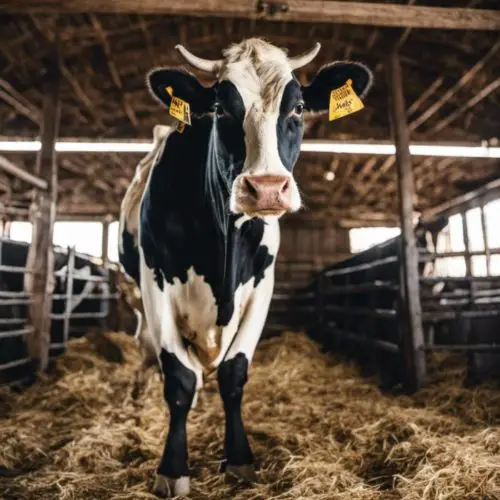Dairy cattle farming is an important agricultural activity in Kenya, contributing about 14% of the Agricultural Gross Domestic Product (GDP) and employing over 1 million farmers.
The dairy sub-sector is the single largest contributor to agricultural GDP in Kenya, worth K.shs 100 billion, higher than tea and horticulture. Smallholder dairy farmers account for 56% of total output, and dairying is a lifeline for the majority of smallholder family farmers and entire pastoral communities of Kenya.
Kenya is well-known as one of Africa’s biggest milk producers, with an estimated population of over 4.5 million dairy cows. The country produces 30-40% of the 5% that Africa contributes to the global milk production.
However, despite the significant contribution of the dairy sector to the Kenyan economy, it faces various challenges that hinder its growth and development.
Despite these challenges, there are various opportunities for growth and development in the dairy sector, including increased investment in research and development, improved access to credit facilities, and the adoption of modern technologies and best practices.
Land and Other Requirements for Dairy Farming in Kenya
Dairy farming is a lucrative business in Kenya, but it requires a considerable amount of investment and planning. Before starting a dairy farm, you need to consider several factors, including the land, capital, and cattle.
Here are some of the essential requirements for dairy farming in Kenya.
Land
The first thing you need to consider when starting a dairy farm is the land. You need to have enough land to accommodate your cattle and grow fodder for them.
The amount of land you require depends on the number of cattle you want to keep. As a general rule, you need at least one acre of land for every three to four dairy cows.
The land should be fertile and have access to water. It should also be well-drained to prevent waterlogging, which can lead to the growth of harmful bacteria and fungi.
You can either buy or lease the land, depending on your financial situation.
Capital
Dairy farming requires a significant amount of capital investment. You need to have enough money to buy land, cattle, and equipment. You also need to have enough money to cover the cost of feed, veterinary care, and labor.
The amount of capital you require depends on the size of your farm and the number of cattle you want to keep. You can either finance the project through a loan or use your savings. It is essential to have a solid business plan before seeking financing to convince lenders that your project is viable.
Cattle
The quality of your cattle determines the success of your dairy farm. You need to select the right breed of cattle that are adapted to the local climate and have a high milk production rate. Some of the popular breeds of dairy cattle in Kenya include:
- Holstein Friesian
- Ayrshire
- Guernsey
- Jersey
You also need to ensure that your cattle receive proper nutrition, healthcare, and breeding. It is essential to work with a veterinarian to develop a vaccination and deworming schedule to prevent diseases and parasites.
In conclusion, dairy farming in Kenya requires careful planning and investment. You need to have enough land, capital, and cattle to start a successful dairy farm. With the right breed of cattle, proper nutrition, and healthcare, you can achieve high milk production and profitability.
Dairy Cattle Farming Methods
When it comes to dairy cattle farming in Kenya, there are several methods that farmers can use to maximize milk production and ensure the health of their animals. Here are some of the most common methods used in dairy cattle farming:
Grazing
Grazing is one of the most traditional methods of dairy cattle farming. It involves allowing the cows to roam freely in a pasture or field, where they can eat grass and other plants.
Grazing is an affordable and natural way to feed your cows, but it requires a lot of land and can be difficult to manage if you have a large herd.
Stall Feeding
Stall feeding involves keeping the cows in a barn or stable and feeding them a combination of hay, silage, and other feeds. This method is more intensive than grazing, but it allows farmers to control the cow’s diet more closely and can result in higher milk production.
Stall feeding is especially useful during the dry season when there is a scarcity of green pastures.
Zero Grazing
Zero grazing is a method that combines the benefits of both grazing and stall feeding. It involves keeping the cows in a confined space, such as a pen or barn, and bringing the feed to them.
This allows farmers to control the cow’s diet more closely, while still providing them with fresh air and exercise. Zero grazing is a popular method among small-scale farmers who don’t have a lot of land.
Artificial Insemination
Artificial insemination is a common practice in dairy cattle farming, where trained technicians insert frozen semen into the uterus of a cow.
This method allows farmers to breed their cows with high-quality bulls, which can result in higher milk production and better genetics. Artificial insemination is less risky and more affordable than natural breeding, but it requires specialized training and equipment.
Bedding
Bedding is a crucial aspect of dairy cattle farming, as it provides the cows with a comfortable place to rest and helps to prevent health problems such as mastitis.
The most common materials used for bedding include sawdust, wood shavings, and straw. Bedding should be changed regularly to keep the cows clean and healthy.
In conclusion, there are several methods that farmers can use for dairy cattle farming in Kenya. Each method has its own advantages and disadvantages, and the best method for your farm will depend on factors such as your herd size, available land, and budget.
By using the right method and taking good care of your cows, you can maximize milk production and ensure the success of your dairy cattle farm.
Housing Requirements for Dairy Farming in Kenya
When it comes to dairy farming, proper housing is essential for the health and well-being of your cows. In Kenya, there are several requirements to consider when building a dairy cow house.
Here are some of the key factors to keep in mind:
1. Space and layout
The amount of space you need for your dairy cow house will depend on the number of cows you have. A good rule of thumb is to have at least 50 square feet per cow.
Your layout should also be designed to allow for easy movement of cows and people, and to minimize the risk of injury to cows.
2. Ventilation
Good ventilation is crucial to maintaining a healthy environment for your cows. Proper ventilation helps to reduce the risk of respiratory diseases and helps to keep the temperature comfortable for your cows.
You should ensure that your dairy cow house has good air circulation, and that there are no areas where air can become stagnant.
3. Lighting
Cows need adequate lighting to produce milk, so it’s important to make sure your dairy cow house has enough natural and artificial light. Natural light is best, so make sure your house has plenty of windows and skylights.
If you need to supplement with artificial light, use high-quality bulbs that mimic natural light.
4. Flooring
The flooring of your dairy cow house should be slip-resistant, easy to clean, and comfortable for your cows to stand on. Concrete is a popular choice, but it can be slippery when wet.
You can add rubber mats or other non-slip materials to improve traction. You should also ensure that the floor is sloped to allow for proper drainage.
5. Water and feeding equipment
Your dairy cow house should have a reliable source of clean water, and feeding equipment that is easy to clean and maintain. You may also want to consider installing a milking parlor, which can help to streamline the milking process and reduce the risk of contamination.
By taking these factors into consideration, you can create a comfortable and healthy environment for your cows, which will help to ensure the success of your dairy farming operation.
Breeds of Dairy Cattle in Kenya
If you are planning to venture into dairy farming in Kenya, you must choose the right breed of cattle. There are several breeds of dairy cattle in Kenya, and each breed has its unique characteristics. In this section, we will discuss some of the most common breeds of dairy cattle in Kenya.
Friesian
Friesian is the most common breed of dairy cattle in Kenya. It is a large breed that typically exhibits the typical pied coat pattern of black and white. Friesian cows are known for their high milk production, and they can produce up to 30 liters of milk per day.
They are also known for their docile nature, making them easy to handle.
Ayrshire
Ayrshire is another popular breed of dairy cattle in Kenya. This breed is known for its reddish-brown and white coat pattern. Ayrshire cows are medium-sized and are known for their high milk production.
They can produce up to 25 liters of milk per day. Ayrshire cows are also known for their strong legs, making them suitable for rough terrain.
Guernsey
Guernsey is a small breed of dairy cattle that is known for its golden brown coat. Guernsey cows are known for their high butterfat content in their milk, making them suitable for butter and cheese production. They can produce up to 20 liters of milk per day.
Jersey
Jersey is a small breed of dairy cattle that is known for its light brown coat. Jersey cows are known for their high milk production, and they can produce up to 18 liters of milk per day. They are also known for their high butterfat content in their milk, making them suitable for butter and cheese production.
Other Breeds
Apart from the above-mentioned breeds, there are several other breeds of dairy cattle in Kenya, including the Sahiwal, Boran, and Zebu. These breeds are mainly used for beef production, but they can also be used for dairy production.
In conclusion, choosing the right breed of dairy cattle is crucial for the success of your dairy farming venture in Kenya. You must consider factors such as milk production, butterfat content, and temperament when choosing a breed.
Feeding and Nutrition
Feeding and nutrition are crucial aspects of dairy cattle farming in Kenya. Proper feeding and nutrition are essential for the growth, health, and productivity of dairy cows.
Inadequate feeding can lead to poor milk production, low body condition, and increased susceptibility to diseases.
Grazing
Grazing is one of the most common feeding strategies for dairy cows in Kenya. This involves allowing the cows to roam and feed on natural pastures. Grazing is relatively low-cost, particularly if the farmer has their land to graze their cows.
However, the quality and quantity of available forage can vary depending on the season and weather conditions.
Forages
In addition to grazing, dairy cows require forages to meet their nutritional requirements. Good forages for dairy cows include grasses such as Kikuyu and napier, Boma Rhodes, lucerne hay, Brachalia, sweet potato vines, desmodium, sorghum, maize, and so on. Good quality maize silage can also be used as a forage.
Concentrates
Concentrates such as dairy meal, maize bran, wheat bran, cottonseed cake, and sunflower cake can be used to supplement the cow’s diet. These concentrates are rich in protein and energy and can help meet the cow’s nutritional requirements.
However, it is essential to ensure that the concentrates are of good quality and are fed in the right amounts.
Water
Water is also an essential component of a dairy cow’s diet. Cows require plenty of clean and fresh water to maintain their health and milk production. A lactating cow can drink up to 100 liters of water per day, depending on the environmental conditions and the cow’s size.
In summary, feeding and nutrition are critical aspects of dairy cattle farming in Kenya. A well-balanced diet that includes grazing, forages, concentrates, and water is essential for the growth, health, and productivity of dairy cows.
Farmers should ensure that their cows have access to high-quality feed and water to maximize milk production and profitability.
Health and Disease Management
When it comes to dairy cattle farming, health and disease management are crucial aspects that require your attention. Here are some tips to help you keep your cattle healthy and free from diseases:
Regular Vaccinations
Vaccinations are essential to prevent your cattle from contracting various diseases. Ensure that you vaccinate your cattle regularly, as per the advice of a veterinarian. Some common vaccines that you should consider include:
- Black quarter vaccine
- Foot-and-mouth disease vaccine
- Anthrax vaccine
- Brucellosis vaccine
Proper Nutrition
Proper nutrition is essential to keep your cattle healthy and free from diseases. Ensure that you provide them with a balanced diet that includes hay, silage, and concentrates. You should also ensure that they have access to clean water at all times.
Cleanliness and Hygiene
Maintaining a clean and hygienic environment is crucial to prevent the spread of diseases. Ensure that you clean the cattle shed regularly and keep it dry. You should also ensure that you dispose of the manure properly to prevent the spread of diseases.
Regular Health Checks
Regular health checks are crucial to detect any health issues in your cattle early. Ensure that you have a veterinarian check your cattle regularly. They will be able to detect any health issues and provide you with the necessary treatment.
Disease Management
Despite your best efforts, your cattle may still contract diseases. It is essential to have a disease management plan in place to prevent the spread of the disease.
Ensure that you isolate the infected cattle and provide them with the necessary treatment. You should also disinfect the cattle shed and equipment to prevent the spread of the disease.
Milk Production and Processing
Dairy farming is a significant agricultural activity in Kenya, with milk production being a common domestic and commercial practice. Milk production is done through the keeping of cattle, goats, camels, and other animals that produce milk suitable for human consumption.
In Kenya, cows are the most common dairy animals, and they can produce between 7 to 9 liters of milk per day when well-fed and taken care of. However, the productivity per cow per day is still low compared to other countries, mainly due to genetics and poor feeding practices.
The dairy industry in Kenya has faced many challenges, including milk production volumes that have stagnated due to changes in agricultural land usage, poor animal husbandry practices, and aging infrastructure at the farms.
Despite these challenges, Kenya’s cows produce over 3.5 billion liters of milk annually, making it the leading milk producer in East Africa.
To improve milk production, farmers in Kenya have adopted various measures such as crossbreeding local breeds with high-yielding exotic breeds and improving animal nutrition. Additionally, the government and other stakeholders have invested in programs aimed at improving animal health, breeding, and extension services to farmers.
After milk production, the milk is processed into various dairy products such as yogurt, cheese, butter, and ghee. Milk processing in Kenya is mainly done by large-scale processors, with small-scale processors accounting for a small percentage of the total milk processed.
The processed milk is then distributed to various markets, including supermarkets, retail shops, and informal markets. The demand for dairy products in Kenya is on the rise, with Kenyans consuming more milk than people in any other country in Africa.
By 2030, Kenya is likely to become a net dairy exporter, according to the International Livestock Research Institute.
Marketing and Distribution of Dairy Products
Once you have produced your dairy products, you need to sell them to make a profit. The Kenyan dairy market is highly competitive, and it is essential to have a good marketing strategy to succeed.
Here are some tips for marketing and distributing your dairy products in Kenya.
Identify your target market
Before you start marketing your dairy products, you need to identify your target market. Who are your potential customers? Are you targeting individual consumers or businesses? Once you have identified your target market, you can tailor your marketing strategy to their needs.
Use social media
Social media is an excellent way to market your dairy products in Kenya. You can use platforms like Facebook, Instagram, and Twitter to reach a large audience. Make sure to post high-quality photos and videos of your products and engage with your followers to build a loyal customer base.
Partner with retailers
Partnering with retailers is an effective way to distribute your dairy products. You can sell your products to supermarkets, grocery stores, and other retailers. Make sure to negotiate favorable terms and build a good relationship with your retailers to ensure a steady supply of customers.
Attend trade shows
Attending trade shows is a great way to showcase your dairy products and network with potential customers and partners. You can attend local and international trade shows to gain exposure and build your brand.
Offer promotions and discounts
Offering promotions and discounts is an effective way to attract new customers and retain existing ones. You can offer discounts on bulk orders, run promotions on social media, or offer loyalty programs to encourage repeat business.
Marketing and distribution are crucial aspects of dairy farming in Kenya. By identifying your target market, using social media, partnering with retailers, attending trade shows, and offering promotions, you can build a successful dairy business in Kenya.
Challenges and Solutions in Dairy Cattle Farming
Dairy cattle farming in Kenya is an important sector that contributes significantly to the country’s economy. However, like any other agricultural activity, it is not without its challenges. In this section, we will discuss some of the challenges faced by dairy farmers in Kenya and possible solutions to overcome them.
Challenge: Low Milk Production
Low milk production is a common challenge faced by dairy farmers in Kenya. This is often caused by poor feeding, inadequate water supply, and inadequate health management. In addition, the use of poor-quality breeds and a lack of proper breeding programs can also contribute to low milk production.
Solution: To increase milk production, farmers should ensure that their animals have access to clean water and quality feed. They should also implement proper health management practices, such as regular deworming, vaccination, and treatment of sick animals.
Farmers should also consider using high-quality breeds and implementing proper breeding programs to improve the genetics of their herd.
Challenge: High Cost of Production
The high cost of production is another challenge that dairy farmers in Kenya face. This is often caused by the high cost of animal feed, veterinary services, and labor.
In addition, the lack of access to credit facilities and high-interest rates can also contribute to the high cost of production.
Solution: To reduce the cost of production, farmers should explore cost-effective ways of producing animal feed, such as growing their own feed or purchasing feed in bulk.
They should also negotiate with veterinary service providers to get better rates and consider sharing labor with other farmers to reduce costs. Farmers should also seek out credit facilities with favorable interest rates to finance their operations.
Challenge: Marketing and Distribution
Marketing and distribution of dairy products can be a challenge for farmers in Kenya, especially those who operate on a small scale. This is often due to a lack of access to markets, inadequate storage facilities, and poor transportation infrastructure.
Solution: Farmers should consider forming cooperatives or joining existing ones to increase their bargaining power and access to markets. They should also invest in proper storage facilities to ensure that their products are well-preserved and not wasted.
Additionally, farmers should work with other stakeholders in the industry to advocate for better transportation infrastructure and policies that support the growth of the dairy industry.
Future Trends in Dairy Cattle Farming in Kenya
Dairy cattle farming is a significant contributor to the Kenyan economy, providing livelihoods for millions of smallholder farmers and pastoral communities. The industry is expected to continue growing in the coming years, driven by several trends and developments.
Increased Adoption of Technology
Advancements in technology have already started to revolutionize the dairy industry in Kenya. For example, innovations like EASYMA 6.0 have made it easier for farmers to weigh their milk and get accurate data about their products, leading to better pricing and improved income.
Going forward, we can expect to see even more technology adoption, such as the use of sensors to monitor cow health and productivity, precision feeding systems, and automated milking machines.
Growing Demand for Organic and Specialty Dairy Products
As consumers become more health-conscious and environmentally aware, the demand for organic and specialty dairy products is expected to rise. This trend presents a significant opportunity for dairy farmers in Kenya to differentiate themselves and capture higher margins.
For example, farmers could focus on producing organic milk, cheese, or yogurt, or explore niche markets like A2 milk or camel milk.
Increased Emphasis on Sustainability
Sustainability is becoming an increasingly important consideration for consumers and businesses alike. In the dairy industry, this means reducing greenhouse gas emissions, conserving water and energy, and promoting animal welfare.
Going forward, we can expect to see more dairy farmers in Kenya adopting sustainable practices like rotational grazing, manure management, and renewable energy generation.
Expansion of Export Markets
Kenya’s dairy industry has traditionally been focused on the domestic market, but there is significant potential for expansion into export markets.
For example, Kenya could export milk powder, cheese, or butter to neighboring countries like Tanzania, Uganda, or Rwanda, or even further afield to markets like the Middle East or Asia.
However, to take advantage of these opportunities, dairy farmers will need to meet international quality and safety standards, which may require investments in infrastructure and technology.
Final Thoughts
In conclusion, dairy cattle farming is a significant sector of Kenya’s economy, contributing to the agricultural GDP of the country. As a dairy farmer, you have the potential to earn a steady income and provide nutritious milk to the population.
To succeed in dairy farming, you must be knowledgeable about the best practices for feeding, breeding, and managing your cattle. It is also essential to keep up with the latest developments in the industry, such as new technologies and government policies.
Remember to prioritize the health and welfare of your cattle, as this will ultimately determine the success of your farm. Regular veterinary check-ups, proper nutrition, and good housing are all crucial components of maintaining healthy animals.
While there are challenges to dairy farming in Kenya, such as fluctuating milk prices and competition from large-scale producers, there are also opportunities for growth and innovation. By staying informed and adapting to changes in the industry, you can build a successful and sustainable dairy farm.
Overall, dairy cattle farming in Kenya is a rewarding and potentially lucrative venture. With dedication, hard work, and a commitment to best practices, you can build a thriving business and contribute to the growth of the dairy sector in Kenya.




